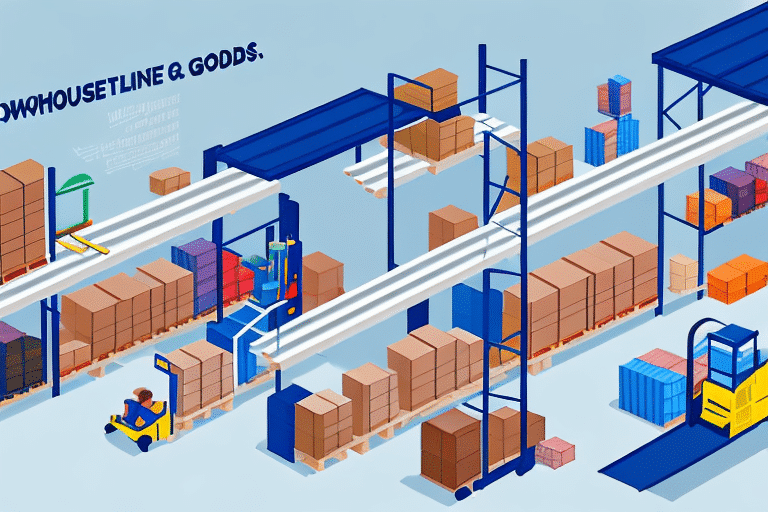Introduction
In the world of e-commerce operations, outbound accuracy is crucial to the success of any business. Accurate outbound shipments ensure that customers receive the correct products in a timely manner, which leads to increased customer satisfaction and loyalty. Inaccuracies in outbound shipments, on the other hand, can result in frustrated customers, negative reviews, and lost business. In this article, we will examine why measuring warehouse outbound accuracy is so important for e-commerce operations, and explore strategies for improving and maintaining accuracy.
The Importance of Accurate Outbound Shipments in E-Commerce Fulfillment
Accurate outbound shipments are the cornerstone of successful e-commerce fulfillment. When customers place an order, they expect to receive the products they ordered, and to receive them in a timely manner. According to a McKinsey & Company report, fulfillment accuracy is a critical factor influencing customer satisfaction, with 85% of consumers considering it essential when choosing where to shop.
Customers who receive inaccurate shipments are likely to become frustrated and may ultimately choose to shop elsewhere. In addition, inaccurate shipments can result in increased costs for the business, such as the cost of reshipping the correct products or handling returns. For instance, the American Express Business Insights indicates that the average cost of processing a return can range from $8 to $15 per item.
By prioritizing outbound accuracy, businesses can improve customer satisfaction, reduce costs, and increase revenue. One effective strategy is to implement a robust quality control process. This can involve:
- Double-checking orders before they are shipped
- Using barcode scanning technology to verify products
- Assigning a designated team member to review and approve each shipment
These steps enable businesses to catch errors before they reach the customer, thereby preventing costly mistakes.
Another critical factor in outbound accuracy is communication. Businesses should provide clear and detailed information to their fulfillment team about each order, including any special instructions or customer requests. This can help prevent mistakes and ensure that each shipment is tailored to the customer's needs. Additionally, maintaining open lines of communication with customers throughout the fulfillment process—such as providing updates on order status and potential delays—can further enhance customer satisfaction and trust.
How Inaccuracies in Outbound Shipments Affect Your E-Commerce Business
Inaccuracies in outbound shipments can have a profound impact on e-commerce businesses. When customers receive incorrect orders, they may lose trust in the business, leading to decreased repeat purchases and diminished customer loyalty. According to the HubSpot State of Marketing Report, businesses with high fulfillment accuracy scores see significantly higher customer retention rates.
In addition to lost sales, inaccurate shipments can result in:
- Negative Reviews: Dissatisfied customers are more likely to leave negative reviews, which can harm the business's reputation and deter potential customers.
- Increased Operational Costs: Handling returns, reshipping orders, and managing customer service inquiries all entail additional costs. For example, Forbes highlights that businesses can lose up to 30% of their revenue due to inefficiencies caused by errors in outbound shipments.
- Employee Morale: Frequent errors can lead to frustration among employees, which can reduce productivity and increase turnover rates.
To mitigate these issues, implementing a comprehensive quality control process is essential. Practices such as double-checking orders before shipment, utilizing barcode scanners, and having supervisors review shipments can significantly reduce the likelihood of errors. By minimizing inaccuracies, e-commerce businesses can enhance customer satisfaction, protect their reputation, and maintain healthy profit margins.
The Costs of Inaccurate Outbound Shipments and How to Minimize Them
The financial implications of inaccurate outbound shipments can be substantial for e-commerce businesses. Beyond the immediate costs of reshipping correct products, inaccuracies can lead to increased labor costs associated with resolving issues. According to a study by The Tool Report, the cost of handling a return can average between $8 and $15 per item, and incorrect shipments can inflate operational expenses by up to 30%.
To minimize these costs, businesses can adopt several strategies:
- Invest in Technology Solutions: Implementing advanced warehouse management systems (WMS) and automation technologies can improve accuracy and efficiency. Technologies such as AI-driven inventory management and automated picking systems can significantly reduce human errors.
- Employee Training Programs: Regular training ensures that employees are well-versed in best practices and understand the importance of accuracy in their roles. Skilled employees are less likely to make mistakes that result in costly errors.
- Monitor Key Metrics: Tracking metrics such as order accuracy rate, shipping error rate, and return rates can help identify areas needing improvement. Using data analytics, businesses can make informed decisions to enhance their fulfillment processes.
Another significant cost associated with inaccurate outbound shipments is the potential loss of customer trust and loyalty. When customers consistently receive incorrect or damaged products, their trust in the business erodes, leading them to seek alternatives. This not only affects immediate sales but can also harm long-term revenue and brand reputation. Therefore, prioritizing accuracy in outbound shipments is crucial for sustaining customer trust and ensuring the financial health of the business.
By adopting these strategies, e-commerce businesses can effectively minimize the costs associated with inaccurate outbound shipments, safeguarding both their bottom line and customer relationships.
Key Metrics for Measuring Outbound Accuracy in E-Commerce Warehouses
Measuring outbound accuracy is essential for identifying areas for improvement and tracking progress over time. Key performance indicators (KPIs) provide valuable insights into the efficiency and effectiveness of warehouse operations. Some critical metrics for measuring outbound accuracy include:
- Order Accuracy Rate: This metric measures the percentage of orders shipped correctly without any errors. A high order accuracy rate indicates efficient fulfillment processes.
- Order Cycle Time: The total time taken from when an order is placed to when it is delivered to the customer. Reducing cycle time can enhance customer satisfaction and operational efficiency.
- Order Fill Rate: This measures the percentage of customer orders that are fulfilled completely on the first attempt. A higher fill rate signifies better inventory management and fulfillment accuracy.
Additionally, the Shipping Error Rate is a vital metric that assesses the percentage of orders shipped with errors, such as incorrect items or quantities. Tracking this metric helps businesses identify patterns and root causes of errors, enabling them to implement targeted corrective actions.
Another important metric is Customer Satisfaction, which can be gauged through customer surveys or by monitoring feedback on social media and review platforms. High customer satisfaction scores related to fulfillment accuracy can indicate effective warehouse operations and strong customer relationships.
By consistently tracking these metrics and setting performance targets, businesses can gain actionable insights into their outbound processes. Data-driven decision-making based on these KPIs can lead to continuous improvement in outbound accuracy, ultimately enhancing overall operational performance and customer satisfaction.
Common Causes of Inaccurate Outbound Shipments in E-Commerce Operations
Several factors can contribute to inaccurate outbound shipments in e-commerce operations. Understanding these causes is crucial for implementing effective solutions to enhance accuracy. Common causes include:
- Picking Errors: Mistakes made during the picking process, such as selecting the wrong item or incorrect quantities, are a primary source of inaccuracies. These errors can occur due to human oversight or inadequate training.
- Inventory Discrepancies: Discrepancies between recorded inventory levels and actual stock can lead to incorrect shipments. Causes include theft, damage, or errors in inventory tracking systems.
- Shipping System Errors: Technical glitches in shipping software can result in incorrect order information being processed, leading to errors in the outbound shipments.
To improve accuracy, businesses should:
- Invest in automated picking systems that reduce reliance on manual processes.
- Implement real-time inventory tracking to ensure accurate stock levels and minimize discrepancies.
- Enhance quality control processes, such as barcode scanning and supervisor reviews, to catch errors before orders are shipped.
Another significant cause of inaccuracies is human error during the packing process. Employees may accidentally include the wrong item in a package or forget to include items altogether. To mitigate human errors, businesses can:
- Implement double-checking procedures where multiple employees verify the contents of each shipment.
- Provide comprehensive training to employees, emphasizing the importance of accuracy and adherence to fulfillment procedures.
Issues with shipping carriers can also lead to inaccurate outbound shipments. Problems such as delays, damages during transit, or incorrect labeling can result in orders not reaching customers as intended. To address these challenges, businesses should:
- Select reliable shipping carriers with proven track records for timely and accurate deliveries.
- Ensure that all packages are properly labeled and documented to prevent misrouting or loss during transit.
By identifying and addressing these common causes of inaccuracies, e-commerce businesses can enhance their outbound fulfillment operations, leading to improved customer satisfaction and reduced operational costs.
Best Practices for Increasing Outbound Accuracy in Warehouse Operations
Implementing best practices in warehouse operations is pivotal for enhancing outbound accuracy. These practices help establish consistency, reduce errors, and optimize overall fulfillment processes. Key best practices include:
- Establish Clear Processes and Procedures: Developing standardized protocols for picking, packing, and shipping ensures that every employee follows the same steps, minimizing the likelihood of errors. Clear documentation and training on these processes are essential for consistent performance.
- Invest in Employee Training Programs: Comprehensive training equips employees with the knowledge and skills needed to perform their tasks accurately. Training should cover best practices, the use of technology tools, and the importance of accuracy in fulfillment operations.
- Implement Quality Control Checks: Regular quality checks, such as final inspections of orders before shipment, can catch and correct errors. Employing technologies like barcode scanners or RFID systems can automate and enhance the accuracy of these checks.
- Utilize Technology Solutions: Advanced warehouse management systems (WMS), automation, and inventory tracking technologies can streamline operations and reduce manual errors. Technologies such as AI-driven analytics can also provide insights for continuous improvement.
- Monitor and Analyze Key Metrics: Regularly tracking metrics related to outbound accuracy, such as order accuracy rate and shipping error rate, allows businesses to identify trends and areas needing improvement. Data-driven analysis supports informed decision-making and process optimization.
- Encourage a Culture of Accountability: Fostering an environment where employees take ownership of their tasks and are motivated to maintain high accuracy standards can significantly boost outbound accuracy. Recognition and incentives for accurate performance can reinforce this culture.
In addition to these practices, regularly reviewing and updating the warehouse's inventory management system is crucial. This ensures that product availability and locations are accurately reflected, reducing the likelihood of errors during the picking and packing processes. Moreover, businesses should continuously evaluate and adopt new technologies that enhance accuracy and efficiency, such as automated conveyor systems or integrated robotics.
By adhering to these best practices, e-commerce businesses can achieve higher levels of outbound accuracy, leading to increased customer satisfaction, reduced operational costs, and a stronger competitive position in the market.
Technology Solutions for Improving Outbound Accuracy in E-Commerce Warehouses
Leveraging technology solutions is a powerful way to enhance outbound accuracy in e-commerce warehouses. Advanced technologies can automate processes, reduce human error, and provide real-time data insights. Some key technology solutions include:
- Automated Picking Systems: Automation technologies, such as robotic pickers and automated guided vehicles (AGVs), can streamline the picking process, increasing speed and accuracy. These systems minimize manual handling, reducing the likelihood of picking errors.
- Real-Time Inventory Tracking: Implementing real-time inventory management systems ensures accurate tracking of inventory levels and locations. Technologies like RFID tagging and IoT sensors provide continuous updates, reducing the chances of stockouts or overstocking.
- Shipping Software: Sophisticated shipping software can automate label generation, track shipments, and integrate with various carriers. Solutions like ShipBob or Shopify Shipping offer features that enhance accuracy and efficiency in the shipping process.
- Warehouse Management Systems (WMS): A robust WMS integrates all warehouse operations, providing a centralized platform for managing inventory, order processing, and shipping. Modern WMS solutions incorporate AI and machine learning to optimize workflows and predict demand trends.
- Barcode Scanning and RFID Technologies: These technologies facilitate precise tracking of products throughout the warehouse, ensuring that the correct items are picked, packed, and shipped. Barcode scanners and RFID readers can significantly reduce manual errors and improve data accuracy.
When implementing technology solutions, it's crucial to consider the training and support needed for employees. While these solutions can streamline processes and reduce errors, they also require employees to adapt to new systems and workflows. Providing comprehensive training and ongoing technical support ensures that employees can effectively utilize the technology and maximize its benefits.
Furthermore, businesses should regularly evaluate the effectiveness of their technology solutions. Monitoring performance metrics and gathering feedback from employees can help identify areas for improvement and ensure that the technologies continue to align with the business's operational goals.
By integrating these technology solutions, e-commerce businesses can achieve higher levels of outbound accuracy, enhance operational efficiency, and deliver superior customer experiences.
Training and Employee Management Strategies for Maximizing Outbound Accuracy
Effective training and employee management are critical components for maximizing outbound accuracy in e-commerce warehouses. Well-trained and motivated employees are essential for maintaining high standards of fulfillment accuracy. Strategies to enhance training and employee management include:
- Comprehensive Onboarding Programs: New employees should undergo thorough onboarding programs that cover company processes, best practices, and the use of technology tools. This foundation ensures that employees start off with a clear understanding of their roles and the importance of accuracy.
- Ongoing Training and Development: Regular training sessions help employees stay updated on new technologies, process changes, and industry best practices. Continuous learning opportunities can enhance employee skills and adaptability.
- Providing Access to Resources and Tools: Employees should have access to the necessary tools, such as updated software, efficient hardware, and informative resources. Equipping employees with the right tools enables them to perform their tasks accurately and efficiently.
- Implementing Regular Feedback Mechanisms: Providing constructive feedback helps employees understand their performance levels and areas for improvement. Regular performance reviews and feedback sessions can guide employees toward higher accuracy and operational excellence.
- Offering Incentives and Recognition: Recognizing and rewarding employees who maintain high accuracy levels can motivate the entire workforce to prioritize accuracy. Incentive programs, bonuses, or public acknowledgment can reinforce the value placed on accurate fulfillment.
- Building a Positive Work Environment: A supportive and positive work culture encourages employees to take pride in their work and strive for excellence. Ensuring that employees feel valued and supported can reduce turnover rates and enhance overall productivity.
Additionally, implementing standardized procedures and checklists can help employees adhere to best practices consistently. Clear guidelines minimize confusion and provide a reference that employees can follow to ensure accuracy in their tasks.
By adopting these training and employee management strategies, businesses can cultivate a workforce that is skilled, motivated, and dedicated to maintaining high levels of outbound accuracy. This, in turn, contributes to enhanced operational efficiency, reduced error rates, and improved customer satisfaction.
Case Studies: Companies that Have Improved Their Outbound Accuracy and the Results They Achieved
Examining real-world examples of companies that have successfully enhanced their outbound accuracy provides valuable insights into effective strategies and their tangible benefits. Here are a few case studies:
Amazon's Automation and AI Integration
Amazon has long been at the forefront of leveraging technology to optimize its warehouse operations. By integrating advanced automation systems and artificial intelligence (AI), Amazon has significantly improved its outbound accuracy. The implementation of Kiva robots for automated picking and sorting has reduced human error, increased processing speeds, and enhanced order accuracy.
As a result, Amazon has achieved higher customer satisfaction levels, leading to a substantial increase in repeat customers and positive reviews. The use of AI-driven analytics has also enabled Amazon to predict demand trends and optimize inventory management, further reducing inaccuracies.
Zappos' Employee Training and Customer-Centric Approach
Zappos, an e-commerce giant in the footwear and apparel industry, places a strong emphasis on employee training and customer satisfaction. By investing heavily in comprehensive training programs, Zappos ensures that its employees are well-equipped to handle the complexities of order fulfillment with high accuracy.
Moreover, Zappos' customer-centric philosophy encourages employees to prioritize accuracy and service quality over speed. This approach has resulted in lower error rates, fewer returns, and higher customer loyalty. The company's dedication to accuracy has been a key driver of its strong brand reputation and sustained growth.
Walmart's Real-Time Inventory Management
Walmart has implemented sophisticated real-time inventory management systems to enhance outbound accuracy across its extensive network of warehouses. By utilizing RFID technology and IoT sensors, Walmart maintains precise control over its inventory levels and locations, minimizing discrepancies that could lead to inaccurate shipments.
The integration of these technologies has enabled Walmart to achieve near-perfect order accuracy, facilitating seamless order fulfillment and timely deliveries. The company's focus on real-time data and automation has not only improved accuracy but also boosted operational efficiency, leading to cost savings and increased profitability.
These case studies illustrate how different strategies—ranging from technology integration to employee training and customer-centric practices—can effectively improve outbound accuracy in e-commerce operations. By adopting similar approaches, businesses can achieve significant results in enhancing their fulfillment processes and overall customer satisfaction.
Overcoming Challenges to Achieving High Levels of Outbound Accuracy in E-Commerce Warehouses
While the benefits of high outbound accuracy are clear, achieving it can present several challenges for e-commerce businesses. Understanding and proactively addressing these challenges is essential for maintaining accurate and efficient warehouse operations. Common challenges include:
- Resistance to Change: Implementing new technologies or processes can encounter resistance from employees accustomed to existing workflows. Overcoming this requires effective change management strategies, including clear communication and employee involvement in the transition process.
- Competing Priorities: Balancing multiple operational priorities, such as speed, cost, and accuracy, can be challenging. Businesses need to prioritize outbound accuracy without compromising other critical aspects of their operations.
- Resource Constraints: Limited financial and human resources can hinder the implementation of accuracy-enhancing measures. Businesses must allocate resources strategically to invest in essential technologies and training programs.
To overcome these challenges, businesses can adopt the following strategies:
- Evaluate and Streamline Processes: Conducting regular audits of fulfillment processes helps identify inefficiencies and areas prone to errors. Streamlining workflows and eliminating unnecessary steps can improve accuracy and reduce operational complexities.
- Build a Culture of Continuous Improvement: Fostering a culture that prioritizes outbound accuracy encourages employees to seek ongoing improvements and take ownership of their roles. Implementing feedback mechanisms and encouraging employee suggestions can drive continuous enhancement of fulfillment processes.
- Leverage Technology: Investing in advanced technologies such as automation, AI, and real-time tracking can address resource constraints by enhancing efficiency and reducing dependency on manual labor. These technologies can significantly reduce error rates and support scalability.
- Provide Comprehensive Training: Ensuring that employees are well-trained and understand the importance of accuracy can mitigate resistance to change. Providing ongoing education and professional development opportunities can enhance employee skills and adaptability.
Additionally, collaborating with experienced technology partners and consultants can provide valuable guidance and support in implementing accuracy-enhancing solutions. By leveraging external expertise, businesses can navigate challenges more effectively and accelerate the achievement of high outbound accuracy levels.
In summary, while challenges exist in achieving high outbound accuracy, proactive strategies such as process optimization, cultural fostering, technological investment, and comprehensive training can help businesses overcome these obstacles. By addressing these challenges head-on, e-commerce companies can maintain accurate and efficient fulfillment operations, leading to sustained success and customer satisfaction.
Industry Trends and Innovations in Measuring and Improving Warehouse Outbound Accuracy for E-Commerce Operations
The e-commerce industry is continuously evolving, with new trends and innovations emerging to enhance warehouse outbound accuracy. Staying abreast of these developments allows businesses to leverage cutting-edge solutions for optimizing fulfillment processes. Current trends and innovations include:
- Machine Learning and Artificial Intelligence: AI and machine learning are being used to predict demand patterns, optimize inventory levels, and automate decision-making processes. These technologies can identify potential errors in fulfillment processes and provide predictive analytics to preempt inaccuracies.
- Blockchain Technology: Blockchain offers a secure and transparent method for tracking inventory and shipments. By providing an immutable ledger of transactions, blockchain can enhance traceability and reduce the risk of errors or fraud in outbound shipments.
- Cloud-Based Warehouse Management Systems (WMS): Cloud-based WMS solutions offer greater flexibility, scalability, and accessibility compared to traditional on-premises systems. These platforms enable real-time data access, seamless integration with other business systems, and remote management capabilities, enhancing overall accuracy and efficiency.
- Internet of Things (IoT) Devices: IoT devices, such as smart sensors and connected machinery, provide real-time data on warehouse conditions, equipment performance, and inventory movements. This data can be used to optimize warehouse layout, monitor equipment health, and prevent inaccuracies related to environmental factors.
- Robotic Process Automation (RPA): RPA involves using software robots to automate repetitive tasks, such as data entry and order processing. By automating these tasks, businesses can reduce manual errors and increase the speed and accuracy of outbound shipments.
Moreover, innovations in virtual and augmented reality are being explored for warehouse training and operational support. These technologies can provide immersive training experiences, enhance employee skills, and offer real-time guidance for complex fulfillment tasks.
Staying updated with these industry trends and integrating relevant innovations can provide e-commerce businesses with a competitive edge. By adopting the latest technologies and best practices, companies can continuously improve their outbound accuracy, operational efficiency, and customer satisfaction levels.
In conclusion, measuring warehouse outbound accuracy is essential for the success of e-commerce operations. By prioritizing accuracy, businesses can improve customer satisfaction, reduce costs, and increase revenue. To achieve high levels of outbound accuracy, businesses should invest in technology solutions, establish clear processes and procedures, implement employee training programs, and monitor key metrics. Additionally, overcoming challenges and staying up-to-date with industry trends and innovations are crucial for sustained success. By following these strategies, businesses can achieve significant results and position themselves for long-term success.




















